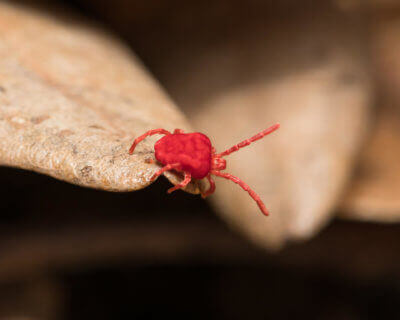Clover Mite Facts & Information
Everything you need to know about clover mites
What Do Clover Mites Look Like

Clover mites are tiny – about the size of a pinhead – and are reddish brown. They differ from many pests in that they prefer cooler weather. Clover mite activity increases as temperatures start to drop, during which time they pay homage to their name by feasting on clovers, over-fertilized grass, and many other plants. In fact, clover mites eat more than 200 different plant species, including some flowers. Their activity peaks in the cooler, early spring months when they can become the greatest nuisance to homeowners, business owners, and landscapers – so be prepared to see clover mites en masse during that time of year. If you see them starting to migrate into your home or building, that would be the time to call in a professional exterminator to deal with clover mite control.
How did I get clover mites
Clover mite infestations are most severe when sudden changes in weather or habitat occur. Populations typically move indoors in autumn when the plants that clover mites feed on start to perish, causing these pests to invade in high numbers — even by hundreds of thousands. That is definitely the kind of numbers that a professional clover mite exterminator needs to deal with. Additional infestations occurring in the spring are typically driven by the sudden growth of lush vegetation around a building’s perimeter, which is especially palatable to clover mites.
Where do clover mites live
Once the hotter summer weather arrives, clover mites will lay eggs and become latent. Depending on the weather that year, they may go into a dormant state around May and remain that way until September. Any eggs that are laid in fall will overwinter until hatching the following spring. These eggs are often positioned in the cracks and crevices of a building’s exterior or between walls, creating issues for all once they hatch.
what Problems do clover mites cause
Despite its name, there’s nothing lucky about finding a clover mite. This dark reddish-brown pest, which is smaller than a pinhead, does not pose a threat to human health or cause major damage to homes or buildings, but it can be a severe nuisance when it invades structures. When smashed, adult clover mites leave behind a red stain, especially on items such as curtains, wallpaper, rugs, and other furniture that are lighter in color. As such, clover mites found inside homes or businesses should be vacuumed up instead of crushed.
How Can I Prevent Clover Mites
There are steps that you can take to prevent clover mite infestations indoors. For starters, thick vegetation or plants that are known to attract clover mites should be removed in an 18 to 24-inch band around the perimeter of the building. Likewise, inspect the structure, including the foundation, window frames, and siding for cracks that may serve as entry points. These spaces should be properly sealed to prevent clover mites from laying eggs or entering the structure. Since they are so tiny, you’re better off with a trained eye to seek them out.
Why Western for clover mite control
We’re passionate about clover mite control because we live and work here – it’s our neighborhood, too. With our almost 100 years of experience keeping homes and businesses in Connecticut, Delaware, New Jersey, New York, and Pennsylvania safe from pests, Western has the experience you can trust.
100% Satisfaction Guarantee
24-Hour Guaranteed Response
Board Certified Entomologists
Say goodbye to clover mites.
GET A QUOTE
“We installed your Termite Defensive a number of years ago and have not seen even one termite since the system was installed.”
Edison, NJ
